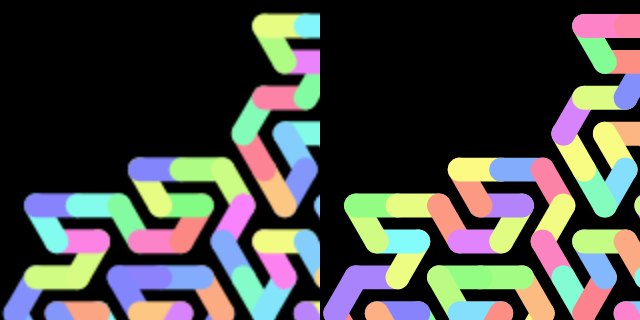This post is the continuation of a very old article I wrote more than 6 years ago. Back then I used Python instead of JavaScript/TypeScript, and I didn’t bother about properly explaining how this works nor any other lesson we can learn from this example. Well, I’m here today to remediate that.
L-Systems
The animated image you can see above is an example of a Gosper curve, which is an interesting particular case of an L-System that also happens to be a space filling curve.
We can understand an L-System as a tuple , where:
- denotes an alphabet (that is, a finite collection of symbols). Example:
a, b, +, - - denotes an initial state (in the form of a string of 1 or more symbols).
Example:
a - denotes a production rule,
or more plainly for our particular case: a function that takes a symbol from
our alphabet and returns us a string of symbols from that same alphabet.
Example:
-➞-+➞+a➞a-b--b+a++aa+b-b➞+a-bb--b-a++a+b
If we take our initial state and recursively apply until a certain predefined depth, we end up with a string that can be interpreted as instructions to draw our curve!
If all this formalism leaves you cold, don’t fret, we’ll jump straight to the code right now! 🎮.
How we structure code
There are 3 very important functions we need to generate our image:
- The 1st one is precisely our “production rule” (the function in charge of generating the “drawing instructions”).
- The 2nd is the one responsible for interpreting the generated instructions and translating them into an ordered list of points on our canvas, that will act as the vertices of our drawing.
- The 3rd function is responsible for taking the ordered list of points and draw coloured lines between them, giving us the final result.
Summary:
start ➞ generate “instructions string” ➞ generate points in space ➞ draw the gosper curve
The Production function
This code is in TypeScript, but it’s pretty straightforward to simplify it and obtain plain JavaScript.
type ChainStep = 'a' | 'b' | '+' | '-'
type Chain = ChainStep[]
const generateChain = (
level: number = 0,
baseChain: Chain = ['a']
): Chain => {
if (level === 0) {
return baseChain.slice(0)
}
const newChain = baseChain.flatMap(rule => {
if (rule === 'a') {
return [
'a','-','b','-','-','b','+','a','+','+','a','a','+','b','-',
] as const
} else if (rule === 'b') {
return [
'+','a','-','b','b','-','-','b','-','a','+','+','a','+','b',
] as const
}
return rule
})
return generateChain(level - 1, newChain)
}The baseChain parameter corresponds to our initial state , while level
is used to indicate how deep is going to go our recursive function. The deeper,
the more complex our final drawing will be.
Generating points
To generate our list of points, we’ll need a couple of helper functions (so we can rotate vectors and add them to points), plus some constants.
type Vector2D = readonly [number, number]
type VectorsIndex = 0 | 1 | 2 | 3 | 4 | 5
const DEG60 = Math.PI / 3 // 60º as radians
const SQUARE_SIDE = 512 // The size of our canvas
// This formula might seem tricky, as it was obtained empirically, although
// it has some solid grounding:
// - Each time we go one level further, each segment is divided into 7 more
// segments.
// - Even at level 0, we only want it to be 3/4 of the square side
// - Powering the divisor to the square root of level is the most difficult
// to justify bit, but it is because we're in a 2d space. If we were in
// 3d, then we would write LEVEL / 3.
const SEGMENT_SIZE = (0.75 * SQUARE_SIDE) / 7.0 ** (LEVEL * 0.5)
const toRight = [SEGMENT_SIZE, 0] as const
const toLeft = [-SEGMENT_SIZE, 0] as const
// See rotation matrix:
// https://en.wikipedia.org/wiki/Rotation_matrix#In_two_dimensions
const rotate2D = ([x, y]: Vector2D, angle: number): Vector2D => {
const cosA = Math.cos(angle)
const sinA = Math.sin(angle)
return [x * cosA - y * sinA, x * sinA + y * cosA] as const
}
const addVector2D = ([x0, y0]: Vector2D, [x1, y1]: Vector2D): Vector2D => {
return [x0 + x1, y0 + y1] as const
}
const inferPointsFromChain = (chain: Chain, firstPoint: Vector2D) => {
const vectorsCircle = [
toRight,
rotate2D(toRight, +DEG60), // toNorthEast
rotate2D(toLeft, -DEG60), // toNorthWest
toLeft,
rotate2D(toLeft, +DEG60), //toSouthWest
rotate2D(toRight, -DEG60), // toSouthEast
] as const
let vectorsIndex: VectorsIndex = 0
let currentPoint = firstPoint
const points = [firstPoint]
for (const step of chain) {
// `a` & `b` indicate us to "advance"
// `+` & `-` indicate us to "change direction"
if (['a', 'b'].includes(step)) {
currentPoint = addVector2D(
currentPoint,
vectorsCircle[vectorsIndex]
)
points.push(currentPoint)
} else if (step === '+') {
vectorsIndex = ((vectorsIndex + 1) % 6) as VectorsIndex
} else if (step === '-') {
// Wee need to add 6 because fmod in JS can return negative
vectorsIndex = ((vectorsIndex - 1 + 6) % 6) as VectorsIndex
}
}
return points
}Extra tweaks for our generated points
To make things easier, we also create a wrapper function that calls the two previously defined functions, and re-aligns our generated points to ensure they are centered in our canvas:
const computeGosperCurveByRules = () => {
const gosperPoints = inferPointsFromChain(
generateChain(LEVEL),
// This 2nd parameter could actually be any point in space because
// we'll re-align all the points afterwards. This was here before we
// introduced the re-alignment code.
[0.625 * SQUARE_SIDE, 0.90625 * SQUARE_SIDE] as const, // starting point
);
let maxX = 0;
let minX = SQUARE_SIDE;
let maxY = 0;
let minY = SQUARE_SIDE;
for (const [x, y] of gosperPoints) {
maxX = Math.max(x, maxX);
maxY = Math.max(y, maxY);
minX = Math.min(x, minX);
minY = Math.min(y, minY);
}
const width = maxX - minX;
const height = maxY - minY;
const shift = [
(SQUARE_SIDE - width) / 2 - minX,
(SQUARE_SIDE - height) / 2 - minY,
] as const;
return gosperPoints.map((p) => addVector2D(p, shift));
}Preparing the canvas and dealing with HiDPI
Ok! that was a lot of code, and we didn’t draw anything yet. But we’re getting close. Now that we know how to generate a list of points, it’s time to draw them.
For that, we’ll prepare our canvas, and we’ll also take care of ensuring that our image doesn’t become blurred on HiDPI screens. In our HTML, we’ll place our canvas object (we could create it in JS as well, of course):
<canvas id='gosperCanvas' height='512px' width='512px'>
Animated Gosper Curve
</canvas>I wrote the following function after noticing that my generated image was slightly blurry, and it is inspired by this article and this StackOverflow post.
function prepareHiDPIContext(canvas: HTMLCanvasElement) {
const dpr = window.devicePixelRatio || 1;
// Get canvas' size in CSS pixels
const rect = canvas.getBoundingClientRect();
// Give the canvas pixel dimensions of their CSS size * the device pixel ratio
canvas.width = rect.width * dpr;
canvas.height = rect.height * dpr;
// Scale down the canvas by the same amount we increased its resolution
canvas.style.width = `${rect.width}px`;
canvas.style.height = `${rect.height}px`;
const ctx = canvas.getContext("2d")!;
// Scale all drawing operations by dpr, to avoid having to deal with it in
// the drawing-focused code.
ctx.scale(dpr, dpr);
return ctx;
}You can see the difference between implementing the rescaling trick or not:

Painting!
This piece of code is relatively big, so I’ll try to explain it before you start with it, to make it easier to understand.
One relevant detail of this code is that we use an HSL color space. We fix saturation and lightness, and let the “hue” change over time, but in discrete steps (I decided to have a relatively small palette, of just 128 colors, plus black).
Another aspect I introduced is that colors change randomly, but they change in the same direction to avoid too much flickery. To achieve that, I introduced some “inertia” that makes the code a bit more complicated, but not by much.
// we limit the amount of color tones used in or drawing
const NUM_TONES = 128;
// just a cached coefficient
const HUES_MULTIPLIER = 360 / NUM_TONES;
// used to control lines thickness
const GAP = SEGMENT_SIZE * Math.cos(DEG30);
const getRandomInt = (max: number) => {
return Math.floor(Math.random() * max)
}
const paint = (canvasId: string) => {
let gosperPoints = computeGosperCurveByRules();
// We assign a randum hue to each one of our points
let hues = Array(gosperPoints.length)
.fill(0)
.map((_) => getRandomInt(NUM_TONES));
// Because we animate color transitions, and we want them to be random, but
// not too flickery, we introduce some "inertia"
let huesInertia = Array(gosperPoints.length)
.fill(0)
.map((_) => getRandomInt(9) - 4);
const gosperCanvas = document.getElementById(
canvasId,
) as HTMLCanvasElement;
const ctx = prepareHiDPIContext(gosperCanvas);
ctx.lineWidth = (GAP * 2) / 3;
ctx.lineCap = "round"; // our line caps are round
ctx.fillStyle = "#000"; // We set black background
// This inner function will take care of redrawing the gosper curve
const animate = () => {
// We update our hue inertia
huesInertia = huesInertia.map((i) => {
const r = Math.random();
if (r < 0.25) {
return Math.max(i - 1, -4);
} else if (r > 0.75) {
return Math.min(i + 1, 4);
} else {
return i;
}
});
// We update our hues
hues = hues.map((hue, index) => {
const inertia = huesInertia[index] as number;
if (inertia >= 3) {
return (hue + 1) % NUM_TONES;
} else if (inertia <= -3) {
return (hue - 1 + NUM_TONES) % NUM_TONES;
} else {
return hue;
}
});
ctx.fillRect(0, 0, 768, 768); // Clearing the canvas using black
let [currentX, currentY] = gosperPoints[0]!;
gosperPoints.slice(1).forEach(([x, y], i) => {
ctx.beginPath();
ctx.moveTo(currentX, currentY);
ctx.strokeStyle = `hsl(${hues[i]! * HUES_MULTIPLIER}, 95%, 75%)`;
ctx.lineTo(x, y);
ctx.stroke();
[currentX, currentY] = [x, y];
});
requestAnimationFrame(animate);
};
animate();
}
// Finally, we call the paint function
paint('gosperCanvas')That would be it! Now, there are still a couple of details that I didn’t work on yet, but I would like to improve:
- Making this animation to be responsive, adapting when presented on small screens, or when we resize our window. In the meantime, you could check this very interesting article about the topic, from Joel Gibson.
- Capturing the generated animations into GIF images and/or videos. I intend to write about this, let’s see if I do it in the end 😅.
Final rant
You might have noticed that I didn’t use any library for the code shown in this
article, and that I directly relied on HTMLCanvasElement functions. There are
reasons for that.
Before I started writting this post, I wrote the same code, but using p5js… and I decided it wasn’t good:
- The provided TS typings are a shabby patch, they don’t properly cover all the details of the library.
- It’s designed to always work in the global scope, making a lot of assumptions about how we organize our code.
- It doesn’t play well with ES Modules.
- It’s very heavy. Using ESBuild, the generated bundle was above 950Kb (versus less than 2Kb without it), and tree shaking doesn’t work with it, probably because of its incompatibility with ES Modules.
Some extras
- You can check how I integrated the animation into this article by checking the MDX source code.
- You can check the Astro component that I created to be embedded into this article.
- The Gosper Curve that I’ve shown here is actually not unique. There are many other curves with similar but different shapes, and there’s even a method to find new ones. You can learn more by reading this article from Fukuda, Shimizu and Nakamura.
